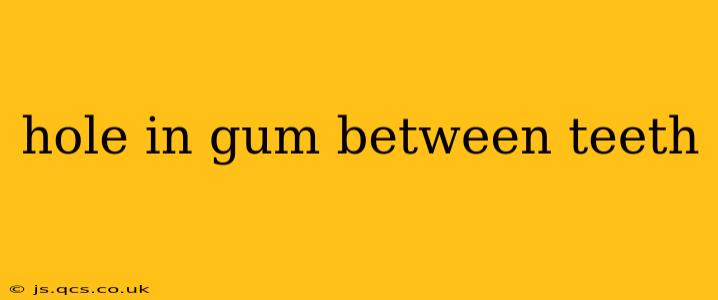A hole in the gum between your teeth, often called a gum recession or periodontal pocket, is a serious dental problem that requires immediate attention. Ignoring it can lead to further gum disease, tooth loss, and other oral health complications. This comprehensive guide will delve into the causes, treatment options, and preventative measures for this concerning issue.
What Causes a Hole in the Gum Between Teeth?
The primary cause of a hole or recession in the gum tissue between teeth is gum disease, specifically periodontitis. Periodontitis is an advanced form of gingivitis (gum inflammation) where the infection spreads to the tissues and bone supporting your teeth. This infection destroys the connective tissues and bone, leading to the formation of pockets between the teeth and gums, creating the visible "hole."
Other contributing factors include:
- Aggressive brushing: While brushing is crucial, harsh scrubbing can wear away gum tissue over time.
- Genetics: Some individuals are genetically predisposed to gum recession.
- Misaligned teeth (malocclusion): Crowded or misaligned teeth can put extra pressure on the gums, contributing to recession.
- Grinding or clenching teeth (bruxism): This habit puts excessive force on the teeth and gums, leading to recession.
- Piercings: Oral piercings, particularly in the gum area, can cause irritation and infection, increasing the risk of recession.
- Hormonal changes: Fluctuations in hormone levels, such as during pregnancy or menopause, can make gums more susceptible to disease and recession.
- Smoking: Smoking significantly impairs the body's ability to heal, making it more difficult to recover from gum disease and increasing the risk of recession.
- Certain medications: Some medications can have a side effect of dry mouth, which increases the risk of gum disease.
How is a Hole in the Gum Between Teeth Treated?
Treatment for a hole in the gum depends on the severity of the gum disease and the extent of the recession. Here are some common treatment options:
- Scaling and root planing: This deep cleaning procedure removes plaque and tartar from below the gum line, smoothing the root surfaces to allow the gums to reattach.
- Antibiotics: In cases of severe infection, antibiotics may be prescribed to fight the bacteria causing the gum disease.
- Gum grafting: This surgical procedure involves taking tissue from another area of the mouth (often the palate) and grafting it onto the receding gum line to cover the exposed root surfaces. Different types of gum grafts exist, such as free gingival grafts, connective tissue grafts, and pedicle grafts, each suited to different situations.
- Guided tissue regeneration (GTR): This advanced technique involves using special membranes to encourage the regrowth of bone and tissue around the teeth.
- Bone grafting: In cases where significant bone loss has occurred, bone grafting may be necessary to support the teeth and improve gum health.
Can a Hole in the Gum Between Teeth Be Prevented?
Preventing gum recession and the subsequent hole formation requires a proactive approach to oral hygiene and regular dental visits.
Prevention strategies include:
- Proper brushing technique: Use a soft-bristled toothbrush and gentle, circular motions.
- Flossing daily: Flossing removes plaque and food particles from between the teeth, where a toothbrush can't reach.
- Regular dental checkups and cleanings: Professional cleanings remove plaque and tartar that you can't remove at home.
- Quitting smoking: Smoking significantly increases the risk of gum disease.
- Managing stress: Stress can exacerbate gum disease.
- Treating bruxism: If you grind or clench your teeth, consider using a mouthguard.
- Maintaining a healthy diet: A balanced diet contributes to overall health, including oral health.
What Happens if a Hole in the Gum Between My Teeth is Left Untreated?
Leaving a hole in the gum between your teeth untreated can lead to several serious consequences:
- Tooth loss: The destruction of supporting bone and tissues can lead to loosening and eventual loss of teeth.
- Increased risk of infection: The exposed root surfaces are more vulnerable to infection.
- Bad breath (halitosis): Bacteria trapped in periodontal pockets can cause persistent bad breath.
- Severe pain and discomfort: Advanced gum disease can cause significant pain and discomfort.
- Systemic health problems: There is growing evidence linking gum disease to other systemic health problems, such as heart disease and diabetes.
How Long Does It Take to Heal a Hole in the Gum Between Teeth?
Healing time varies greatly depending on the severity of the condition and the treatment chosen. Simple cases of gingivitis might resolve with improved oral hygiene in a few weeks. More extensive procedures like gum grafting may take several months to heal completely. Regular follow-up appointments with your dentist are crucial for monitoring progress and ensuring successful healing.
This information is for general knowledge and does not constitute medical advice. Always consult with a qualified dentist or periodontist for diagnosis and treatment of any oral health concerns. They can assess your specific situation and recommend the best course of action.
